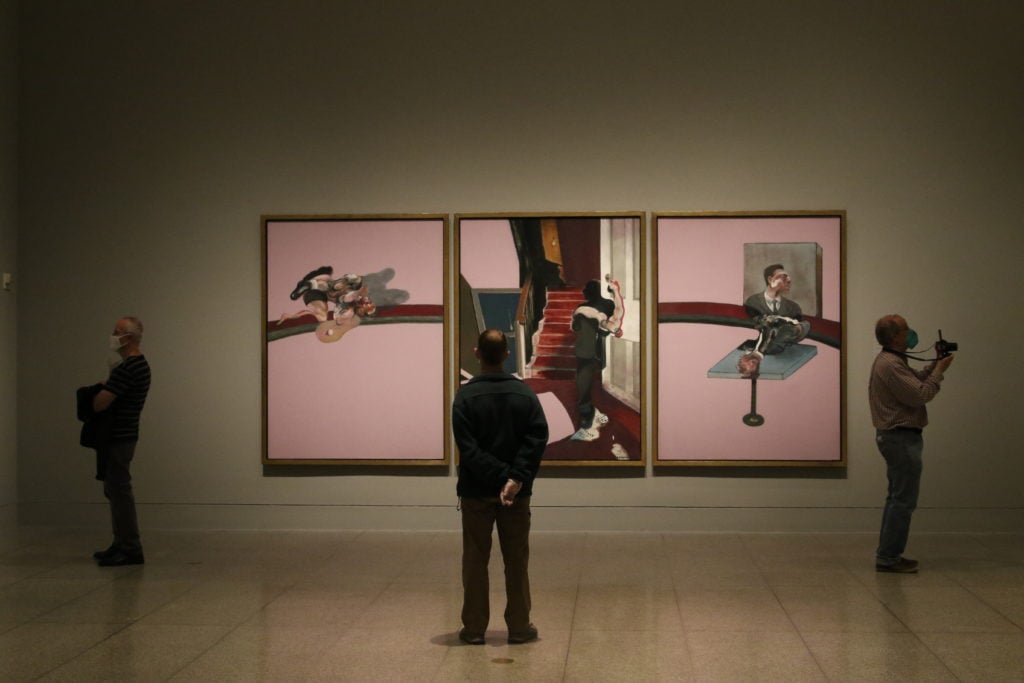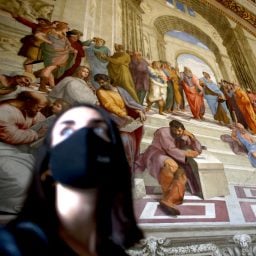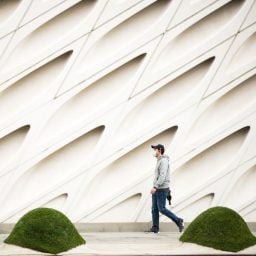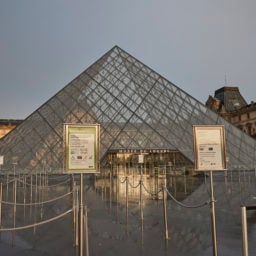Art museums in the United States are figuring out when and how to reopen. They will be greeted by a changed world. To resume operations successfully, they need not only to minimize the risk of infection by the COVID-19 virus to visitors, volunteers, and staff, but also—critically—to instill confidence in all three parties.
In the absence of coordinated government policy or a commonly recognized and certified standard that a museum can demonstrate that it has met, museum leaders are looking to one another for advice, as well as to peer organizations worldwide, some of which are now reopening. They are seeking to coordinate efforts regionally and locally, in order to pool expertise and procurement power; to instill public confidence; and to encourage the adoption of agreed practices in visitors and audiences. Professional and sectoral bodies, including the AAM, AAMD, ICOM, and CIMAM, have put out initial guidance, as have organizations in the adjacent fields of entertainment, performing arts, retail, sport, and tourism.
That said, each museum has to find its own tailored solution within common frameworks, and in its own time. What all of them share is the need to work through a bewilderingly complex array of operational and policy considerations, and quickly.
There is no one-size-fits-all approach. Each museum’s location and its particular configuration of buildings and physical spaces will call for different design solutions. The financial implications of various opening scenarios are also more or less punitive. City and state regulations differ, making choices—such as whether to require or request that visitors wear a face mask—a judgement call with practical, legal, and, regrettably, even political ramifications. (You can read personal accounts on the reopening process from three different museum directors here.)
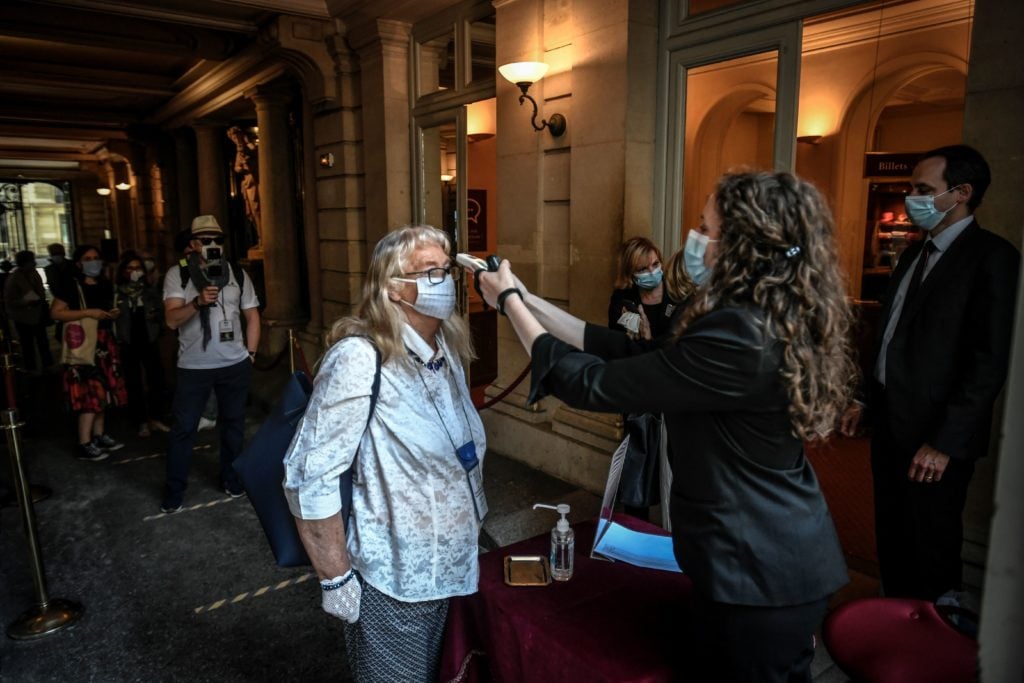
A staff member checks the body temperature of a visitor at the entrance of a Turner exhibition at the Jacquemart-André Museum in Paris on May 26, 2020. Photo by Stephane De Sakutin/AFP via Getty Images.
Technologies for mass temperature testing and measuring social distance are developing, but for the most part not yet operational. The availability of cleaning materials, PPE, protective dividers, and other equipment varies enormously. Every community is in a different place on the trajectory of the pandemic. And at some unknown point—as most believe and all hope—this moment will be behind us, requiring museums to revisit whatever measures have been put in place.
The prospect of reopening under the current circumstances also raises vexing strategic dilemmas. In recent years, museums have developed a sophisticated understanding of the many barriers to entry they inadvertently create, and how to overcome them, in order to pursue agendas informed by equity and social justice. No one wishes to raise additional barriers now. But visiting museums will inevitably become more difficult, not less, for the foreseeable future, and this will affect some visitors more than others. For example, differently abled people are more likely to use high-touch equipment, such as museum-provided wheelchairs or elevators.
We are some way from the “no-touch” museum, in which carefully elaborated protocols and technologies are harnessed to create a frictionless visitor experience. Interior retrofits to accommodate social distancing and more healthy airflows may in due course make for less obtrusive ways of ensuring public health, if the pandemic lasts long enough to require these kinds of structural changes.
So how to navigate this maze? The table below consolidates current thinking about the operational realities of reopening in a way that could be helpful to museum professionals at the sharp end of re-entry, as they try to find their way to a sustainable balance of public access, public safety, and financial and organizational reality. The chart is a work of aggregation rather than invention, and it has no claim to being the first or the final word on how to reopen, let alone when. Rather, it is a snapshot of informed guidance and opinion currently available, drawing on sources in the museum field and outside of it as of May 2020. (For a full list of sources, scroll to the bottom and click to unroll.)
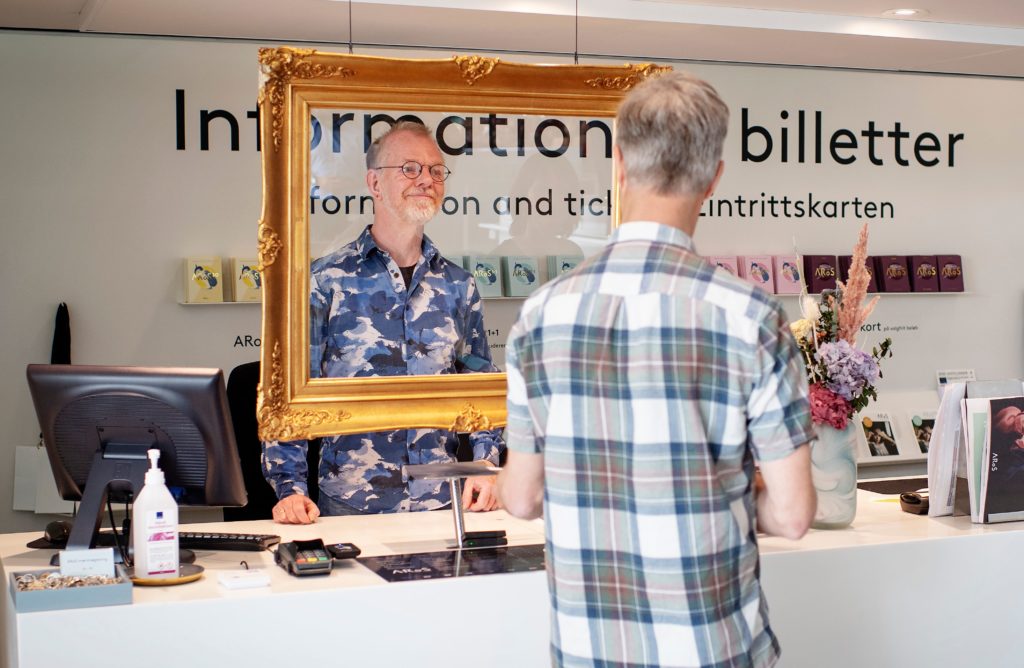
An employee is protected by a shield at the box office of the newly reopened ARoS Museum of Art in Aarhus, Denmark on May 22, 2020. Photo by Bo Amstrup/Ritzau Scanpix/AFP via Getty Images.
The bold headings on the chart list seven broad operational areas that require attention in the context of reopening. The bulleted headings identify specific measures that are candidates for action, generating a checklist intended to help museum managers and staff to establish their relevance. Click on each bulleted header to unroll additional, more detailed planning steps. These are merely prompts for consideration given that the urgency, feasibility, and cost of implementing the measures differs greatly among institutions.
While our aim has been to synthesize the myriad practical considerations museums must tackle to reopen, we are equally aware that reopening is not simply about a set of activities required to welcome back the public. It is also about dealing with the psychological toll that COVID-19 has taken on museum staff. Tactical planning tools like this are by definition operationally focused. At its simplest: museums and their leaders will need to create welcoming conditions for their staff to feel safe and supported if these institutions are to operate.
This exercise was prompted by the overwhelming response to András’s recent Artnet News article, which argued for the importance of art museums’ reopening as soon as practicable and made some initial suggestions as to how they might do so. For helping us collect and organize the material, we wish to thank, in particular, Adam Levine, who took up his position as director of the Toledo Museum of Art in the middle of the lockdown period. We also thank Christine Anagnos (AAMD), Mary Ceruti (Walker Art Center), Kaywin Feldman (National Gallery of Art), and Amy Gilman (Chazen Museum of Art), Sarah Pasti, and Lisa Beth Podos, among others, for their foundational work, observations, and feedback.
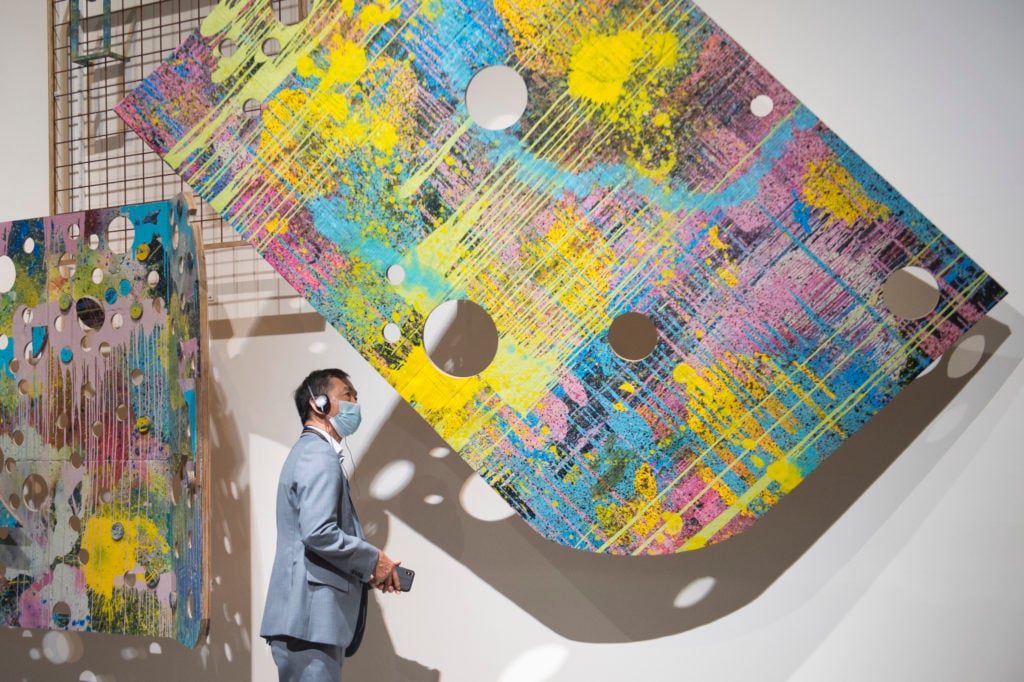
A masked man taking in the display at the Taipei Fine Art Museum on May 22, 2020. Photo by Lin Yen Ting/SOPA Images/LightRocket via Getty Images.
Finally, our planning chart is deliberately silent on the larger, more substantive visioning museums will have to consider after the pandemic. What lies on the other side of reopening is surely articulating a purpose in a changed context, defining appropriate and sustainable programming, and advancing connections and partnerships that inform an institution’s contribution to society. But these ambitions can only be realized if museums are open.
Adrian Ellis is a director of AEA Consulting and the chair of the Global Cultural Districts Network. András Szántó is an author and the founder of András Szántó LLC in New York.
Reopening Museums: An Interactive Planning Tool (Just Click Each Line to Expand)
Access a downloadable PDF of this table
-
-
1. Preparing staff
-
Defining priorities and roles
- -Establish re-entry task force—with subgroups as appropriate—to clarify immediate, midrange, and long-range objectives
- -Review impact on staffing: e.g., need for site health and safety officers, increased invigilation of high-traffic areas, increased cleaning and temperature testing; survey the impact of partial reopening on front-of-house staffing
- -Consider heightened on-site medical provision (e.g., doctor or nurse on call)
- -Consider “A” and “B” (and possibly “C”) teams in rotation in the office, with others at home to maintain social-distance protocols
- -Develop flexible HR policies that deploy staff optimally, making reasonable accommodations for at-risk employees or those uncomfortable coming back to work
- -Review use of docents in light of the above
- -Align with public-health guidance and labor policies
- -Amend mandatory and voluntary training
- -Establish protocols in the event a visitor becomes sick on site, or if an infected visitor is confirmed to have been on site (cleaning; notification of potentially exposed staff and, via social media, visitors; contact tracing)
- -Establish protocols for addressing and, as appropriate, de-escalating noncompliance incidents
-
Securing employee well-being
- -Develop badge-in or other identification process to capture who is on-site for contact tracing purposes
- -Explore practicability of regular and accessible testing, whether on-site or via local health partners
- -Consider psychological counseling and tele-health options, including a remote employee assistance program
- -Address employee concerns about privacy, vulnerability
- -Either close staff canteen or ensure food service via boxed meals
- -Limit and define areas where staff can congregate (break rooms, elevators, etc.)
- -Suspend use of shared appliances and, where that is impossible, develop appropriate cleaning protocols
- -Limit vehicle occupancy, e.g., to one driver and one passenger
- -Consider protocols for transport to and from work if people are using public transportation
-
Orientation about new operating protocols
- -Prepare staff for public-facing roles, including responsibilities and protocols for handling nonconforming members of the public
- -Establish regular orientations and information sharing
- -Provide protective coverings (PPE) and training in their use
- -Establish initial deep-cleaning and subsequent enhanced-cleaning strategy: analyze staff and visitor “touchpoints,” such as front desks, computers, phones, handrails, elevator buttons; sanitize touchscreens and bathrooms (stall door latches, hand driers, etc.)
- -Minimize staff travel, and consider suspending staff travel for a defined period immediately after reopening
-
2. Preparing Facilities
-
Undertaking site and operational planning
- -Audit facilities to evaluate implications of distancing
- -Conduct risk assessment of visitor and work spaces, per OSHA guidance
- -Consider special access points for older and vulnerable visitors
- -Establish compliance with leases and local landlord regulations
- -Revise hours of operation, including special access times for older and vulnerable visitors, and review designated members’ hours
- -Limit hours to ensure adequate time to clean
- -Undertake planning to develop one-way flow through galleries
- -Consider a phased reopening, expanding the open footprint over time
- -Determine which galleries/spaces/elevators will be off-limits to the public
- -Determine which artworks/installations will be off-limits to the public
- -Identify a “sick room” for visitors taken ill during their visit
- -Seek to conform with ADA guidelines when implementing these measures
-
Installing protections and partitions
- -Seek consultation of infectious-disease and occupational-safety experts in redesigning museum spaces
- -Reconfigure workspaces to create more distance between employees
- -Procure or make plexiglass partitions at welcome desks, office cubicles, museum retail stores
- -Procure and provide retractable belt barriers and stanchions for lines
- -Mark floors to indicate safe distances, where useful
- -Prohibit sharing of devices (e.g., audio guides) as needed
- -Review scope for touchless ticketing and limitation of cash transactions
-
Ramping up hygiene and cleaning
- -Implement updated cleaning strategy
- -Specify CDC-approved hospital-grade, and child-safe cleaning supplies that are also non-toxic to artworks
- -Install hand sanitizers at entrance points, internal intersections, bathrooms, retail shops, and restaurants/cafes
- -Audit and replace or regularly clean plastic and stainless steel surfaces that may retain virus
- -Employ germ-killing blue-light equipment where applicable
- -Consider antibacterial floor mats
- -Ensure adequate supplies of equipment, e.g., wipes, electrostatic sprays, UV-light sterilizers
- -Consider increasing the ratio of fresh to recirculated air in offices and public circulation areas
-
Placing signage
- -Clearly post entry-point rules, orientation signage, and signage on cleaning protocols
- -Add floor decals that designate proper distancing
- -Place wall orientation signage and distancing reminders throughout public space
- -Position distancing-in-line reminder stanchions
- -Post external orientation signage at initial access points
- -Consider adapting touch screens to voice- or motion-activated devices
-
3. Communicating and Coordinating for Safety
-
Coordination with relevant public agencies and organizations
- -Address compliance with ADA and OSHA guidelines, including those relating to discriminatory practices
- -Coordinate reopening policies and language with local/regional cultural organizations to maximize effective communication
-
Legal and contractual preparations
- -Establish level of indemnification from liability lawsuits, review and amend insurance policies (e.g., with micro-biological-agent coverage) if needed
- -Establish coverage for force majeure under insurance
- -Develop policies and script for engaging visitors on medical issues and taking medical information
-
Informing the public
- -Publish and explain new procedures on all media channels to manage expectations—including data protection and storage protocols
- -Establish targeted communications channels (social, newsletter, web micro-site) to pool pandemic-related information and provide updates
- -Consider the museum’s role more generally as a public-information point vis à vis public health
- -Clearly state policy regarding acceptable group size
- -Issue alerts to notify the public of changes to pandemic-response status
- -Consider a guest tip line for feedback and to instill confidence in institutional response
-
4. Utilizing Outdoor Areas
-
Coordinating external crowd management
- -Where applicable, limit arrivals at site perimeter
- -Employ signs throughout parking lots that make people feel welcome but also remind them of the need for social distance
- -If possible, monitor these areas so expectations are managed from outset
- -Establish a weather-protected waiting area for people to stand in line
- -Develop socially distant, staggered entry protocol responsive to the site design and existing infrastructure
-
Offering outdoor art experiences
- -Design and facilitate self-guided art tours (where possible)
- -Designate picnic and relaxation areas
-
Adapting parking and parking structures
- -Limit parking capacity to help reduce access (where applicable)
- -Reconfigure newly available parking space for visitor processing
- -Consider implementing timed parking-reservation system
-
Erecting temporary structures
- -Establish a visitor orientation and welcome tent
- -Erect a sanitizing facility
-
5. Managing Arrival
-
Mitigating inflow
- -Consider timed (and time-limited) attendance via online registration, and discouragement or prevention of walk-up attendance
- -Set and enforce maximum attendance (e.g., 1 visitor per 150 square feet), keeping in mind that current advice varies
- -Consider a “soft opening” for members or other groups to work out kinks in the inflow process
- -If your museum charges admission, consider a free soft opening to test management of bottlenecks
- -Where useful and possible, funnel visitation evenly to various parts of the museum (e.g. mark entry tickets to start in different locations)
- -Consider self-service bag and coat check via lockers
-
Orienting and informing visitors
- -Consider audio announcements and erect signs explaining procedures
- -Consider cellphone tours or mobile apps for artwork interpretation and information
- -Replace paper handouts with screens where possible
-
Ensuring protective coverings
- -Promulgate face-mask protocol (e.g., required for staff and recommended for visitors 6 years and above)
- -Develop a policy with respect to protective coverings
-
Taking body temperature
- -Deploy and train thermometer-gun crew
- -If possible, deploy remote thermal scanners at public and staff entrances
- -Establish medical-triage area (if possible outside the building) to process visitors with elevated temperatures for further screening
- -Consider other testing as medical knowledge advances (e.g., pulse oximetry)
-
Compiling and tracking visitor information
- -Consider the adoption of visitor-registration and contact-tracing measures at admission points, to permit contact tracing if necessary
-
6. Distancing Indoors
-
Enforcing physical distancing
- -Institute a six-foot distance minimum between non-family members
- -Use floor decals in areas where queuing is likely
- -Suspend group tours and activities until further notice
- -Assess viability of current generation of social-distancing apps
-
Establishing one-way routing
- -Define and indicate one-way walking paths in corridors and galleries
- -Define no-go zones where distancing is not practicable
-
Distancing in public areas
- -Introduce guidelines for guards to enforce distancing in public circulation areas (where guard staff is contracted, address via contract)
- -Position guards in major intersections to steer public to under-trafficked areas
-
Distancing in the galleries
- -Set and enforce maximum number of visitors per gallery
- -Add people-to-people distancing to gallery guard or attendant responsibilities
- -Remove benches; replace with distanced chairs
- -Ensure sufficient circulation distance between all artworks and displays
- -Disable or cover all touch-activated exhibits/interactives
-
7. Reducing Bottlenecks
-
Upgrading washroom sanitation
- -Employ attendants or other systems to monitor usage and retain possibility of social distance
- -Install no-touch taps and towel dispensers
- -Deploy automatic hand-drying machines, where available
-
Adapting restaurants and cafés
- -Close restaurants and cafés unless they can meet the same standards as other food-service providers in the state
- -Establish and enforce maximum capacity limit (e.g., 30 to 60 percent)
- -Provide boxed lunches instead of served meals
- -Adopt cashless payment
- -Close all water fountains
-
Rethinking museum retail
- -Set maximum number of shoppers
- -Consider stocking face masks and sanitary and protective equipment for sale
- -Create more space between aisles
- -Shift to online fulfillment where possible
- -Adopt cashless payment
-
Evaluating elevators and stairways
- -Restrict small elevators to staff and emergency use only
- -Indicate direction of foot traffic on stairways
-
Limiting use of lecture halls, education spaces, and events
- -Offer take-home activity kits in lieu of group workshops
- -Suspend large galas and rental events until further notice
-
Sources and Resources
- American Alliance of Museums. How to Get Ready to Open Doors, April 29, 2020.
- American Alliance of Museums. Considerations for Museum Reopenings, May 4, 2020.
- American Civil War Museum. COVID-19 Action Plan (n.d.).
- CIMAM. Precautions for Museums during Covid-19 Pandemic, April 28, 2020.
- Coronavirus Preparedness Community Document (n.d.).
- Crow, Kelly. “As Museums and Galleries Reopen, Visitors Face New Rules,” Wall Street Journal, May 2, 2020.
- Cushman & Wakefield. “Recovery Readiness: A How-to Guide for Reopening your Workplace,” April 22, 2020.
- Deloitte. How COVID-19 is Challenging Orthodoxies in Airport Customer Experience (n.d.).
- IAAPA. COVID-19 Reopening Guidance: Considerations for the Global Attractions Industry, May 1, 2020.
- JDSUPRA. Preparing for Re-Entry: Key Considerations for Returning Employees to the Workplace amid the COVID-19 Crisis (n.d.).
- Ministero per i beni e le attività culturali e per il turismo. Coronavirus, Franceschini: Da CDM Aitui Concreti Per Il Turismo e La Cultura (n.d.).
- Museum Tinguely. COVID-19 Protection Concept (n.d.).
- Podos, Lisa Beth. A Playbook for Reopening Children’s Museums Site (n.d.).
- Staatliche Museen zu Berlin. Information on the Opening of Selected Museums, May 12, 2020.
- Theodore Gnep Kipfing. “Key Post-COVID-19 Measures for Operators of Shopping Centers & Other Public Spaces,” April 28, 2020.
- The Event Safety Alliance Reopening Guide. For Event Professionals During the Covid-19 Epidemic. Steven A. Adelman, ed. May 11, 2020.
